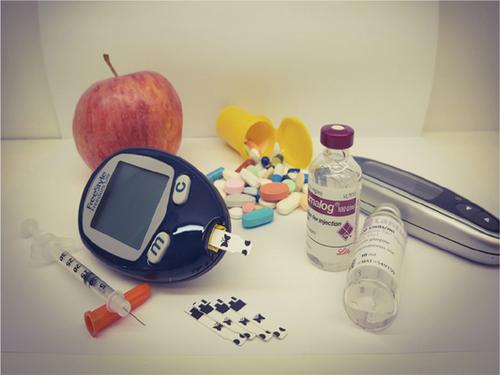Current Topics in Medicinal Chemistry ( IF 2.9 ) Pub Date : 2020-11-30 , DOI: 10.2174/1568026620666200716113813 Worood Sirhan 1 , Ron Piran 1

|
Cells are mainly dependent on glucose as their energy source. Multicellular organisms need to adequately control individual glucose uptake by the cells, and the insulin-glucagon endocrine system serves as the key glucose regulation mechanism. Insulin allows for effective glucose entry into the cells when blood glucose levels are high, and glucagon acts as its opponent, balancing low blood glucose levels. A lack of insulin will prevent glucose entry to the cells, resulting in glucose accumulation in the bloodstream. Diabetes is a disease which is characterized by elevated blood glucose levels. All diabetes types are characterized by an inefficient insulin signaling mechanism. This could be the result of insufficient insulin secretion, as in the case of type I diabetes and progressive incidents of type II diabetes or due to insufficient response to insulin (known as insulin resistance). We emphasize here, that Diabetes is actually a disease of starved tissues, unable to absorb glucose (and other nutrients), and not a disease of high glucose levels. Indeed, diabetic patients, prior to insulin discovery, suffered from glucose malabsorption.
In this mini-review, we will define diabetes, discuss the current status of diabetes treatments, review the current knowledge of the different hormones that participate in glucose homeostasis and the employment of different modulators of these hormones. As this issue deals with peptide therapeutics, special attention will be given to synthetic peptide analogs, peptide agonists as well as antagonists.
中文翻译:

糖尿病治疗和达到正常血糖的其他策略的当前方法。
细胞主要依赖葡萄糖作为其能量来源。多细胞生物需要适当地控制细胞对单个葡萄糖的吸收,胰岛素-胰高血糖素内分泌系统是关键的葡萄糖调节机制。血糖水平高时,胰岛素可使葡萄糖有效进入细胞,而胰高血糖素可作为其对手,从而平衡低血糖水平。胰岛素的缺乏会阻止葡萄糖进入细胞,导致葡萄糖在血液中积聚。糖尿病是以血糖水平升高为特征的疾病。所有糖尿病类型均以低效的胰岛素信号传导机制为特征。这可能是胰岛素分泌不足的结果,例如I型糖尿病和II型糖尿病的进行性事件或由于对胰岛素的反应不足(称为胰岛素抵抗)。我们在这里强调,糖尿病实际上是一种饥饿的组织疾病,无法吸收葡萄糖(和其他营养物质),而不是高血糖水平的疾病。实际上,在发现胰岛素之前,糖尿病患者患有葡萄糖吸收不良。
在这个小型回顾中,我们将定义糖尿病,讨论糖尿病治疗的当前状态,回顾有关参与葡萄糖体内稳态的不同激素的当前知识以及这些激素的不同调节剂的使用。由于此问题涉及肽治疗剂,因此将特别注意合成的肽类似物,肽激动剂以及拮抗剂。











































 京公网安备 11010802027423号
京公网安备 11010802027423号